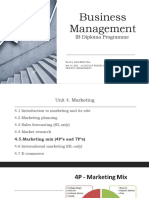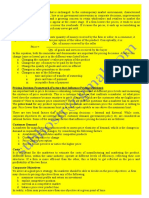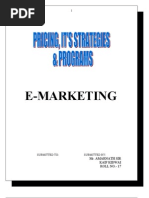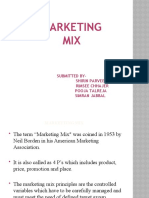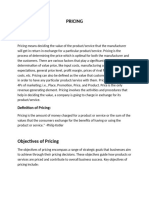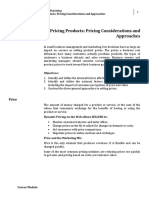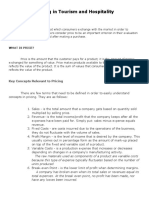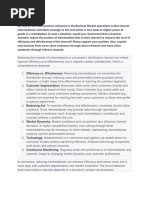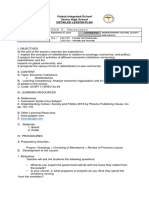B 2 B
B 2 B
Uploaded by
lauraCopyright:
Available Formats
B 2 B
B 2 B
Uploaded by
lauraOriginal Description:
Original Title
Copyright
Available Formats
Share this document
Did you find this document useful?
Is this content inappropriate?
Copyright:
Available Formats
B 2 B
B 2 B
Uploaded by
lauraCopyright:
Available Formats
CHAPTER 10: PRICING IN B2B MARKETING
The price is a strategic element of marketing mix which indicates the value or
worth of something. Without the price, transactions could not take place.
VALUE-BASED PRICING:
Is a price-setting strategy where prices are set primarily on consumers´ perceived
value of the product or service. It is difficult to stablish.
Perceived value is the value of an item or service as constructed in the minds of
consumers. It directly affects the price a consumer is willing to pay.
Companies that offer unique or highly valuable features or services are better
positioned to take advantage of value-based pricing than are companies with
commoditized products and services.
Examples of industries subject to value-based pricing: fashion industry, automotive
sector, cosmetic and personal- care.
COST BASED PRICING:
Is a price-setting strategy where the selling price is stablished by adding a profit
element (percentage) in addition to the cost of producing, distributing and selling
the product (evaluated price). Also, the company normally adds a fair rate of return
to compensate for its efforts and risks. It is easier to stablish but it is often
mistakenly used.
Costs are important when determining profit levels but, beyond this, cost has a
little to do with price.
THE TOTAL OFFERING:
Elements of the offering include: product, service, image, availability, quantity and
evaluated price.
Suppliers creatively combine components of the total offering that contribute to
value for specific customers. Components will vary depending on specific customer
needs and the customer´s cost structure.
The consumer perceives price as a cost in its offering. While some customers will
be able to directly fund purchases while others will require financing assistance.
Some may require just in time delivery while others may find value in the brand or
image of a supplier, particularly if that image can add value to the final product.
Costs considered in Evaluated Price from the consumer perspective:
- Price paid, or value exchanged at purchase.
- Location convenience.
- Handling and storage costs for customer.
- Inventory financing or holding costs.
- Environmental impact or disposal cost.
RELEVANT COSTS: refer to the objective costs of implementing a business decision.
RESULTANT COSTS: Costs that result from the decision.
REALIZED: Actual costs incurred.
FORWARD LOOKING INCREMENTAL: Costs that will be incurred after the
next units of product sold when the decision is implemented.
AVOIDABLE: Costs that would not be incurred if the decision were not made
to launch the offering.
CONTRIBUTION MARGIN: Lets the company determine the profitability of its individual
products. It is the difference between ongoing attributable costs and ongoing
attributable revenue.
Represents the portion of revenue that contributes to:
-Fixed costs
-Indirect costs
-Profit
ECONOMIC FUNDAMENTALS OF PRICE:
Demand levels differ at different levels of price.
Changes in price yield reaction from customers.
Changes in price yield reaction from competitors.
STRATEGIC PURPOSES OF PRICING:
- Achieve target level of profitability
- Build good-will or relationships (in a market with certain customers)
- Penetrate a new market or segment
- Maximize profits for a new product
- Keep competitors out of an existing customer base
TACTIC PURPOSES OF PRICING:
- Win business of new, important customers
- Penetrate a new account
- Reduce inventory levels
- Keep business of disgruntled customers
- Encourage customer trials
- Encourage purchase off complementary products
PRICING CONSIDERATIONS THROUGH THE PRODUCT LIFE CYCLE (PLC) AND
TECHNOLOGY ADOPTION LIFE CYCLE (TALC)
o Pricing is situational
o Customer perceptions of value change
o Different market segments attracted at different stages in life cycle
o Competitive environment changes
o Role of offering in both marketer´s and customer´s organization will change
MARKET SKIMMING
Price skimming is a product pricing strategy by which a firm charges the highest initial
price that customers will pay and lowers it over time. This takes advantage of early
adopters´ strong desire for the product.
As the demand of the first customers is satisfied and competition enters the market, the
firm lowers the price to attract another, more price-sensitive segment.
Firms often use skimming to recover the cost of development.
Market conditions necessary for success in Price Skimming:
- Perception must reflect high price
- Market is inelastic
- Sustainable market advantage
- Competitive market entry blocked
- Production levels profitable at lower volumes
MARKET PENETRATION PRICING
Penetration pricing focuses on releasing a lower-priced product to grab as much market
share as possible in the early market. Generally, this technique is better-suited for lower-
cost items, such as basic household supplies, where price may be a driving factor in most
customers' production selections.
Market conditions necessary for success in Penetration Pricing:
- Market somewhat elastic
- Low price acts as barriers
- Economies of scale are necessary
MANAGING PRICING TACTICS:
BUNDLING: Marketing strategy that joins products or services together to sell
them as a single combined unit. The products and services are usually related,
but they can also consist in dissimilar products which appeal to one group of
customers.
DISCOUNTS AND ALLOWANCES: Reductions to selling price of goods or services.
They can be applied anywhere in the distribution channel.
COMPETITIVE BIDDING: Process of issuing a public bid with the intent that
companies will put together their best proposal and compete for a specific
project.
INITIATING PRICE CHANGES: In many cases, companies must initiate either a
price cut or a price increase. But initiating price changes should be done right to
lead to success. Customer response to PRICE CUTS is normally better than to
price increases.
- Price cuts reduce the profit margin of the company
- Successful price increases can greatly improve profits
NEGOTIATING SITUATIONS IN B2B SALES:
STAGES OF NEGOTIATION PROCESS:
1. PREPARATION: Includes collection and analysis of data, and the determination
of the Negotiation Strategy.
2. INFORMATION EXCHANGE: Collecting information not yet obtained and testing
of hypothesis about nature of situation.
3. ENGAGE IN NEGOCIATION: Opening, discussion of positions, concessions and
closing.
4. OBTAIN COMMITMENT
FINAL NEGOTIATION CONSIDERATIONS:
- Who has the authority to make final decisions?
- What the bargaining styles of participants in bargain decision are.
- Bargain is perceived as a transaction, a relationship or both.
- The evaluated price range expected by the customer
PRICING AND THE CHANGING BUSINESS ENVIRONMENT:
- TIME COMPRESSION
- HYPER COMPETITION
- INTERNET
CHAPTER 13: B2B BRANDING
Bran equity and brand value are similar, but not the same. Brand equity refers to the
importance of a brand in the customer´s eyes, while brand value is the financial
significance the brand carries. Both brand equity and brand value are educated
estimates of how much a brand is worth.
BRANDING CHECKLIST
BRAND IDENTITY:
o Convey a consistent brand identity to the target audience (logo, colors,
designs, etc.)
o Accurately reflect the company or product´s key attributes.
o Make the staff understand what the brand stands for and their roles in
delivering on the brand promise.
o Always deliver on the brand promise.
o Protect the brand identity: set a guideline on how the various brand
elements should be used.
BRAND AWARENESS:
o Make the brand easily recognizable for the target audience
o Make the brand be on top of targets audience´s mind when consider
purchasing.
o Make you brand feature on all relevant marketing material.
COMPETITIVE POSITIONING/ MARKET AWARENESS:
o Understand the brand positioning in the marketplace
o Ensure a competitive edge in the marketplace
o Be aware of potential opportunities in the market
LOOKING TO THE FUTURE- THE PROCESS
o Organizational structure, operations and culture should be aligned with
the brand values
o Review the brand and what it stands for annually
o Continually monitor the brand internally and externally through systems
in place.
IMPORTANCE OF BRAND IN B2B BUYING BEHAVIOR
“A recognized brand name with positive customer perception has advantage at all stages
of decision making”
1. Determine that a need exists
2. Determine product specifications
3. Acquire solution providers
4. Cull the bids/ proposals to a short list
5. Evaluate the short list or get revised proposal/ bids.
6. Cut the short list to finalists
7. Presentations
8. Final evaluation and choice
9. Post purchase relationship
HOW DO MANUFACTURER´S BRANDS BECOME STANDARD?
- First with new technology
- Being the best with service
- Innovating to meet the need
DEFENDING THE MARKET POSITION- There will be imitators
MARKET UP: Build relationships with management above the influencers to reinforce
the decision process.
MARKET DOWN: Build relationships with the lower level users of the product or service.
MARKET SIDEWAYS: Build relationships in other parts of the organization to facilitate
translation of current or future products within the customer organization.
CHAPTER 15: COMMUNICATING WITH THE MARKET
PROVIDING VALUE THROUGH COMMUNICATION:
Members of the buying center respond to messages and media are means of
delivering messages.
These messages must assist members of the buying center to progress through the
buying decision process.
Messages must be crafted to implement the positioning chosen in the design of
marketing strategy.
Implications for getting the best messages to audiences in business marketing
communications:
- Be aware of differences in jargon (jergas) between industries.
- Be aware of limitations/ distortions introduced by various media.
- Seek feedback quickly, in all forms, to make adjustments as necessary.
- Recognize that the customer, the message and the media combined should be
selected as the most appropriate for the customers´ industry.
GENERAL PROMOTIONAL MIX:
PERSONAL SELLING: It is a person to person conversation. Its immediate
feedback allows adaptation of message. Costly per contact, but effective in
persuasion.
ADVERTISING: It is a paid access to media – monologue conversation often with
no direct feedback which need to carry a short message. Low cost per contact
but not good for direct influence on final decision.
SALES PROMOTION: Inducements to action- enhance value.
There are 3 kinds of promotions:
-Sales promotion focused on sales team support
-Sales promotion focused on middlemen support- “push” promotions
-Sales promotion focused on customers- “pull” promotions
PUBLIC RELATIONS: Efforts to get favorable coverage (employing creativity) of
the business by third-party media and publics- convey simple messages through
third-party media. It includes the necessity to build a relationship with media
and its useful to retain PR agency.
THE BUYING DECISION PROCESS AND POTENTIALLY EFFECTIVE METHODS OF NON-
PERSONAL COMMUNICATIONS
PROCESS FLOW NON-PERSONAL USING…
STAGES COMMUNICATION
CAN…
DEFINITION STAGE Help identify problems Advertising
Problem definition Provide info for defining Websites
Solution definition solutions Trade show
Product specification Help customers participation
remember vendors Publicity
SELECTION STAGE Provide info on vendor, Website
Solution provider products and partners Direct mail
search
Acquire solution
provider
DELIVER SOLUTION Deliver services and Website
STAGE trading info
Customize s needed
Install/test/train
END GAME STAGE Provide reinforcement Website
Operate solution Deliver service info Advertising
Reach end result Share performance data Public relations
Evaluate outcomes for evaluation
Determine next set of
needs
GOOD COMMUNICATION: Starts with knowledge of customers and maintains clear
and consistent message.
Web communication allows many messages to be perceived by people in other
segments.
Any incongruence will quickly be noted and communicated across the web to other
segments.
NONPERSONAL PROMOTION
PRINT PROMOTION: Print advertising, direct mail advertising, Corporate
advertising, sales and support literature.
SALES PROMOTION: Channel promotions and promotional merchandise.
TRADE SHOWS AND CONFERENCES: It is a personal selling method which includes
product presentations and demonstrations. It’s an opportunity to build relationship
between customers, channels and company sellers and to learn about customers and
competitors.
Customer memory and credibility are built here with presentations, seminars, panel
discussion participation, premium merchandise and print promotion.
Trade show key decisions include: which shows to attend, who should go and what
statement or positioning should design of exhibits reinforce.
PUBLIC RELATIONS:
- Cover the technical sessions and industry-trends panel discussions by conduct.
- Comb the exhibit floor for interesting new products and company marketing
programs
- Conduct personal interviews with company insiders.
WEB AND INTERNET IN B2B: Internet communications facilitate rapid detailed
interaction between customer, marketer, seller and service person. Its advantages are:
low-cost interactivity and immediacy (real time or near-real time feedback and
adaptation).
Internet communications can be effective in any stage of the buying decision process.
An effective internet communication requires:
-To know about the customers as well as possible
-To coordinate Internet communications with other forms of communications.
-To track effectiveness: server logs offer good data on user or customer response
behavior.
Internet communication tools are: Website, opt-in email, newsletters, webinars, blogs
and social media.
You might also like
- DP1 BM Unit 4 Topic 4.5. Marketing Mix OKNo ratings yetDP1 BM Unit 4 Topic 4.5. Marketing Mix OK87 pages
- Ajmal - 1550 - 4118 - 1 - Pricing Strategy For Industrial Markets - Lecture # 14No ratings yetAjmal - 1550 - 4118 - 1 - Pricing Strategy For Industrial Markets - Lecture # 1444 pages
- Pricing Decisions: Meaning and Significance of PriceNo ratings yetPricing Decisions: Meaning and Significance of Price44 pages
- Pricing Over The Product Life Cycle: Adapting Strategy in An Evolving MarketNo ratings yetPricing Over The Product Life Cycle: Adapting Strategy in An Evolving Market27 pages
- Pre-Test:: Is The Process of Designing, Creating and Marketing New Products or Services To Benefit CustomersNo ratings yetPre-Test:: Is The Process of Designing, Creating and Marketing New Products or Services To Benefit Customers78 pages
- Pricing Strategy Review in Telecom SectorNo ratings yetPricing Strategy Review in Telecom Sector40 pages
- Pricing: 1. What Is Pricing and Why Is It Termed As Critical Management Function?No ratings yetPricing: 1. What Is Pricing and Why Is It Termed As Critical Management Function?11 pages
- Marketing Mix: Transnational Business Analysis - Workbook, 2No ratings yetMarketing Mix: Transnational Business Analysis - Workbook, 29 pages
- Week 012-Module Pricing Considerations and ApproachesNo ratings yetWeek 012-Module Pricing Considerations and Approaches4 pages
- Chapter 6 Strat Formulation Long Term Goals PP Slides 2024No ratings yetChapter 6 Strat Formulation Long Term Goals PP Slides 202422 pages
- Summaries of Chapters: Karachi University Business SchoolNo ratings yetSummaries of Chapters: Karachi University Business School9 pages
- Developing Pricing Strategies & ProgramsNo ratings yetDeveloping Pricing Strategies & Programs28 pages
- Making Strategic Decisions - Strategic Marketing Management 0 Strategic Production ManagementNo ratings yetMaking Strategic Decisions - Strategic Marketing Management 0 Strategic Production Management23 pages
- Value-based Intelligent Pricing: Marketing and Business, #1From EverandValue-based Intelligent Pricing: Marketing and Business, #1No ratings yet
- The Profit Zone (Review and Analysis of Slywotzky and Morrison's Book)From EverandThe Profit Zone (Review and Analysis of Slywotzky and Morrison's Book)No ratings yet
- Customer willingness to pay: How to use pricing to boost your salesFrom EverandCustomer willingness to pay: How to use pricing to boost your salesNo ratings yet
- Digital Economics: How Information and Communication Technology is Shaping Markets, Businesses, and Innovation 1st Edition Harald Øverby 2024 scribd download100% (2)Digital Economics: How Information and Communication Technology is Shaping Markets, Businesses, and Innovation 1st Edition Harald Øverby 2024 scribd download40 pages
- Corporate Strategy - Supply Chain Management - Dell Case Study100% (1)Corporate Strategy - Supply Chain Management - Dell Case Study22 pages
- Akshay Kapoor - Rev - Synopsis C - S FinancialNo ratings yetAkshay Kapoor - Rev - Synopsis C - S Financial12 pages
- Reading 5 - Market Based Solutions An Appropriate Approach To Resolve Environmental ProblemsNo ratings yetReading 5 - Market Based Solutions An Appropriate Approach To Resolve Environmental Problems6 pages
- (Case Study 1) 0dte Options - A Comprehensive Overview0% (1)(Case Study 1) 0dte Options - A Comprehensive Overview3 pages
- Marketing Plan For Aski Ausaid Agri CenterNo ratings yetMarketing Plan For Aski Ausaid Agri Center7 pages
- The High Price of Customer SatisfactionNo ratings yetThe High Price of Customer Satisfaction13 pages
- Renaissance Securities (Cyprus) Limited Professional Clients & Eligible CounterpartiesNo ratings yetRenaissance Securities (Cyprus) Limited Professional Clients & Eligible Counterparties34 pages
- Risk and Rates of Return: This Chapter Is Most Important and Will Be Emphasized in TestsNo ratings yetRisk and Rates of Return: This Chapter Is Most Important and Will Be Emphasized in Tests66 pages
- Ajmal - 1550 - 4118 - 1 - Pricing Strategy For Industrial Markets - Lecture # 14Ajmal - 1550 - 4118 - 1 - Pricing Strategy For Industrial Markets - Lecture # 14
- Pricing Decisions: Meaning and Significance of PricePricing Decisions: Meaning and Significance of Price
- Pricing Over The Product Life Cycle: Adapting Strategy in An Evolving MarketPricing Over The Product Life Cycle: Adapting Strategy in An Evolving Market
- Pre-Test:: Is The Process of Designing, Creating and Marketing New Products or Services To Benefit CustomersPre-Test:: Is The Process of Designing, Creating and Marketing New Products or Services To Benefit Customers
- Pricing: 1. What Is Pricing and Why Is It Termed As Critical Management Function?Pricing: 1. What Is Pricing and Why Is It Termed As Critical Management Function?
- Marketing Mix: Transnational Business Analysis - Workbook, 2Marketing Mix: Transnational Business Analysis - Workbook, 2
- Week 012-Module Pricing Considerations and ApproachesWeek 012-Module Pricing Considerations and Approaches
- Chapter 6 Strat Formulation Long Term Goals PP Slides 2024Chapter 6 Strat Formulation Long Term Goals PP Slides 2024
- Summaries of Chapters: Karachi University Business SchoolSummaries of Chapters: Karachi University Business School
- Making Strategic Decisions - Strategic Marketing Management 0 Strategic Production ManagementMaking Strategic Decisions - Strategic Marketing Management 0 Strategic Production Management
- Value-based Intelligent Pricing: Marketing and Business, #1From EverandValue-based Intelligent Pricing: Marketing and Business, #1
- Beyond e (Review and Analysis of Diorio's Book)From EverandBeyond e (Review and Analysis of Diorio's Book)
- The Profit Zone (Review and Analysis of Slywotzky and Morrison's Book)From EverandThe Profit Zone (Review and Analysis of Slywotzky and Morrison's Book)
- Customer willingness to pay: How to use pricing to boost your salesFrom EverandCustomer willingness to pay: How to use pricing to boost your sales
- Digital Economics: How Information and Communication Technology is Shaping Markets, Businesses, and Innovation 1st Edition Harald Øverby 2024 scribd downloadDigital Economics: How Information and Communication Technology is Shaping Markets, Businesses, and Innovation 1st Edition Harald Øverby 2024 scribd download
- Corporate Strategy - Supply Chain Management - Dell Case StudyCorporate Strategy - Supply Chain Management - Dell Case Study
- Reading 5 - Market Based Solutions An Appropriate Approach To Resolve Environmental ProblemsReading 5 - Market Based Solutions An Appropriate Approach To Resolve Environmental Problems
- (Case Study 1) 0dte Options - A Comprehensive Overview(Case Study 1) 0dte Options - A Comprehensive Overview
- Renaissance Securities (Cyprus) Limited Professional Clients & Eligible CounterpartiesRenaissance Securities (Cyprus) Limited Professional Clients & Eligible Counterparties
- Risk and Rates of Return: This Chapter Is Most Important and Will Be Emphasized in TestsRisk and Rates of Return: This Chapter Is Most Important and Will Be Emphasized in Tests


